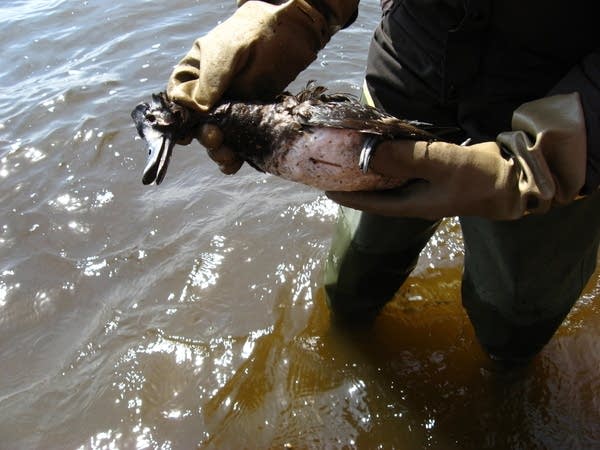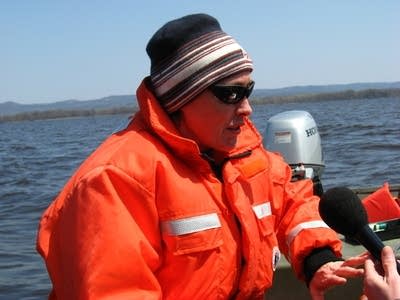A new threat to duck populations

May is the end of the spring migration season on the Mississippi. More than 450,000 ducks travel the Mississippi flyway each year. Lake Onalaska is one of the birds' resting and feeding stops on their trip north. It's a backwater of the Mississippi near La Crosse, Wisc.
I'm motoring along a small island on a john boat with biologists from the Fish and Wildlife Service. They're looking for dead ducks. Jim Nissen sits at the bow of the john boat squinting. He thinks he spots one.

"Is that a coot in the rocks there? There's a bird right there, scaup. There's one up on and there's one in the water right there," he points them out to his colleague.
Nissen is the district manager of the refuge. He climbs out of the boat in his waders and checks the sex of the scaup. The Fish and Wildlife Service is trying to determine whether more females than males are dying.
Create a More Connected Minnesota
MPR News is your trusted resource for the news you need. With your support, MPR News brings accessible, courageous journalism and authentic conversation to everyone - free of paywalls and barriers. Your gift makes a difference.
This one is a female, and it's been there for about a week.
Calvin Gehri usually counts birds in this section of the river. This season Gehri has found more than 100 in Lake Onalaska and more than 1,000 just south of it. From that number he extrapolates that roughly 4,000 birds have died this spring just in this portion of the refuge. That's bad, but the number isn't as high as in past years.
I ask him if seeing all of these dead birds creeps into his dreams.

"Yeah, it gets to be pretty heartbreaking sometimes. Come out and see all these birds and there's nothing that can be done for them when they reach that point," he says.
The birds die after ingesting an invasive snail that's been infested with parasites. Both the snail and the parasites are invasive. The ducks die within three to eight days of eating the snails. Sometimes birds die floating in the water like decoys. Lesser scaup and coots are the two duck species most affected by these parasites.
Three types of intestinal parasites killing these birds, Wildlife Refuge district manager Jim Nissen says.
"They all, all three, use an invasive snail called the mud bithynia or the faucet snail as an intermediate host."
Most of the bird deaths have been around Lake Onalaska. But the snails have spread, and most of them are now infested with parasites. They've traveled north to Red Wing and spread south to Dubuque, Iowa. That's close to another major scaup migration stop. Biologists aren't sure how the snails or the parasites are spreading. One of the parasites was originally found on the east side of Wisconsin.
The ducks eat the snails for protein, and then the parasites bore into the intestinal walls of the ducks, Nissen says.
[image]
"They gorge on blood and then lay eggs, the eggs are passed through the birds feces and that's how they reach the snails. That's how the cycle is perpetuated."
The parasites don't seem to be affecting the predators that eat the ducks or humans. But they are hurting the scaup population. Nationally, the number of lesser scaup has dropped from eight million in 1972 to 3.4 million last spring, according to Ducks Unlimited, a conservation group.
These die-offs come at a time when duck population is already shrinking, according to Jennifer Sauer, a biologist for the U.S. Geological Survey. She's helping design strategies to combat the snail.
"You have habitat loss, you have possible feed resources that are declining, and then you add a wildlife disease to the mix you don't know what the cumulative effect will be to the population," she says.
That's frustrating to Sauer because so much effort has been made to create better habitat for birds on the refuge. So far, researchers haven't found a way to stop the snails or the parasites. The snails like submerged rock.

Last year refuge staff poured sand and gravel into the crevices of that rock to deter the snails from attaching. That worked until the waves eroded the sand. They've also considered chemicals to kill the snails, but those could destroy native mussels.
This year they'll try to redesign some of the man-made islands so the snails find them less attractive. They're also looking for places where the snails winter, hoping to kill the population then. But for now, they don't have many good leads.


